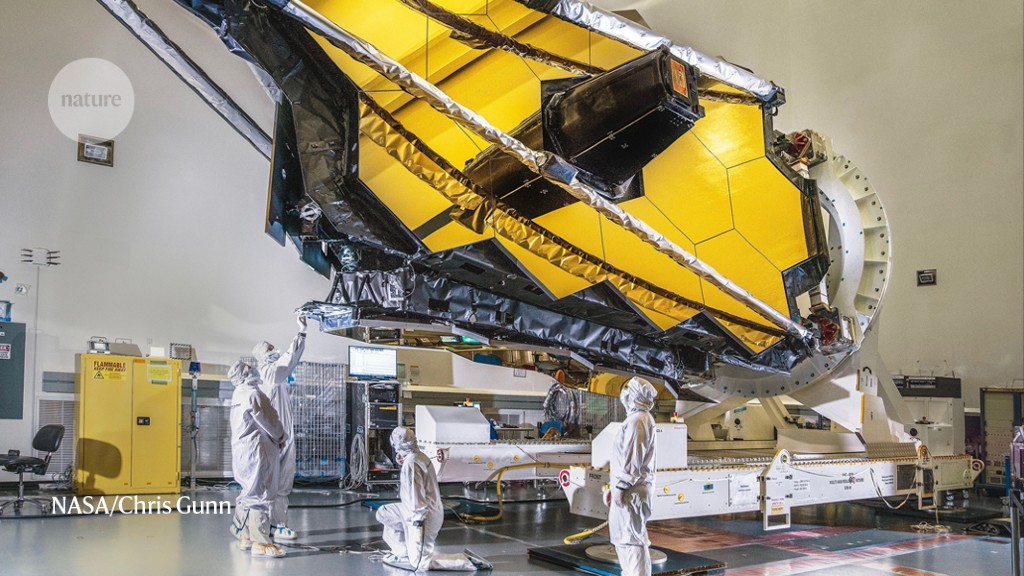The $11-billion Webb telescope aims to probe the early Universe
Lisa Dang wasn’t even born when astronomers started planning the most ambitious and complex space observatory ever built. Now, three decades later, NASA’s James Webb Space Telescope (JWST) is finally about to launch, and Dang has scored some of its first observing time — in a research area that didn’t even exist when it was being designed.
Try Adsterra Earnings, it’s 100% Authentic to make money more and more.

Dang, an astrophysicist and graduate student at McGill University in Montreal, Canada, will be using the telescope, known as Webb for short, to stare at a planet beyond the Solar System. Called K2-141b, it is a world so hot that its surface is partly molten rock. She is one of dozens of astronomers who learnt in March that they had won observing time on the telescope. The long-awaited Webb — a partnership involving NASA, the European Space Agency (ESA) and the Canadian Space Agency (CSA) — is slated to lift off from a launch pad in Kourou, French Guiana, no earlier than 22 December.
If everything goes to plan, Webb will remake astronomy by peering at cosmic phenomena such as the most distant galaxies ever seen, the atmospheres of far-off planets and the hearts of star-forming regions swaddled in dust. Roughly 100 times more powerful than its predecessor, the Hubble Space Telescope, which has transformed our understanding of the cosmos over the past 31 years, Webb will reveal previously hidden aspects of the Universe.
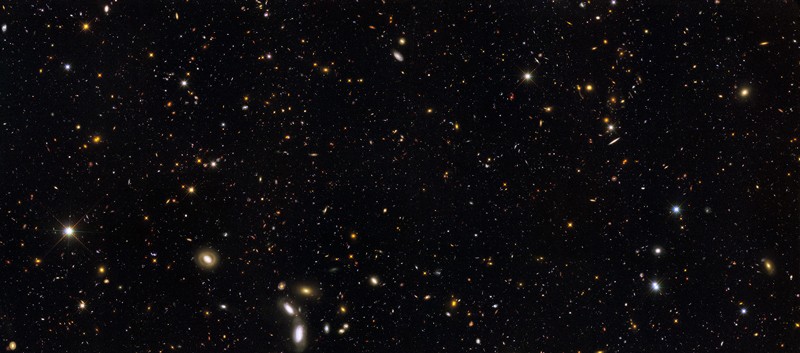

The Webb telescope will spend hundreds of hours surveying this patch of sky, seen here in an image from the Hubble Space Telescope that captures 7,500 galaxies, some more than 13 billion years old.Credit: NASA, ESA, Rogier Windhorst (ASU), S. Cohen (ASU), M. Mechtley (ASU), M. Rutkowski (ASU), Robert O’Connell (UVA), P. McCarthy (OCIW), N. Hathi (UC Riverside), R. Ryan (UC Davis), Haojing Yan (OSU), Anton M. Koekemoer (STScI)
“Webb has such transformative capabilities that — to me — it’s going to be the ‘before’ times and the ‘after’ times,” says Jane Rigby, an astrophysicist at NASA’s Goddard Space Flight Center in Greenbelt, Maryland, who serves as Webb’s operations project scientist.
But if anything goes wrong, it will be an ignominious setback to what is already the most expensive astronomical gamble in history. The telescope took decades and more than US$10 billion to develop, and frequent delays repeatedly ate into NASA’s astrophysics budget. Just this year, the telescope has been enveloped in controversy over whether it ought to remain named after James Webb, who headed NASA in the 1960s when a NASA employee was fired on suspicion of being gay. Webb also held a high-ranking position in the US Department of State in the late 1940s and early 1950s, at a time when that department was systematically rooting out and firing gay and lesbian people because of their sexual orientation.
When the telescope lifts off after so many delays and so much debate, it will carry with it the hopes of thousands of astronomers around the world. “There aren’t many times in your life when you’re on the cusp of such a big thing,” says Heidi Hammel, an astronomer and vice-president for science at the Association of Universities for Research in Astronomy in Washington DC, who has worked on Webb for decades. “There are a lot of emotions.”
Decades of development
The first glimmers of what would become Webb arose at a workshop at the Space Telescope Science Institute in Baltimore, Maryland, in 1989. It was the year before the launch of the Hubble Space Telescope, and scientists were already thinking about how to follow up that transformative observatory. What ultimately emerged were plans for a space telescope with a 6.5-metre-wide primary mirror, nearly three times the size of Hubble’s, and made up of 18 hexagonal segments. The mirror is so large that it must be folded up like origami during launch and unfurled once in space. Shading it will be a kite-shaped sunshield the size of a tennis court, made of five aluminium-coated layers that block the Sun’s heat and keep the telescope cool enough to operate.
Webb’s overall cost was originally estimated at $1 billion — an appraisal few believed even then — and has since ballooned. NASA provided US$9.7 billion, including funds to cover operating costs in space; €700 million (US$810 million) came from ESA; and the CSA contributed Can$200 million (US$160 million). The project’s skyrocketing costs drew intense scrutiny from government auditors as well as perennial questions as to whether it would be worth its unprecedented price tag. “To be truly transformational in a field, you have to build the tool you need,” says Hammel. “This is what it costs to do this.”
Plagued by repeated cancellations and design changes, the telescope finally took shape in laboratories around the world and was then assembled at Goddard. It was later combined with the rest of the observatory at Northrop Grumman Aerospace Systems in Redondo Beach, California. There, Webb ran into even more trouble when technicians damaged it by using the wrong solvent to clean propulsion valves. Later, screws literally came loose during testing.
Now, 32 years after its conception, Webb is finally sitting at the spaceport in Kourou in preparation for launch. It is destined for a point in space 1.5 million kilometres from Earth — too far away for astronauts to visit and fix the telescope if something goes wrong. Hubble required an after-launch repair in 1993, when astronauts used the space shuttle to get to the Earth-orbiting observatory and install corrective optics for its primary mirror, which had been improperly ground.
If it launches successfully, Webb will probe the cosmos in the near- to mid-infrared wavelengths, most of which are longer than Hubble can see. That means Webb can study light that has travelled from faraway galaxies and been stretched to redder wavelengths by the expansion of the Universe. Webb will also be able to study dust that enshrouds star-forming regions as well as the gas between the stars, both of which are not as visible at shorter wavelengths. Like Hubble, it will be able to take spectra of astronomical objects, meaning it can split their light into components to determine what they are made of.
Earth’s atmosphere interferes with most ground-based infrared astronomical studies. Space-based telescopes, such as ESA’s Herschel Space Observatory, which operated between 2009 and 2013, have explored the Universe in infrared light before. But Webb’s enormous mirror and suite of sensitive instruments (see ‘New eye in the sky’) mean that its discoveries will surpass those of any previous infrared space telescope, scientists say. “It’s going to change a lot of what we know about a lot of areas of astronomy,” says Jeyhan Kartaltepe, an astronomer at the Rochester Institute of Technology in New York.
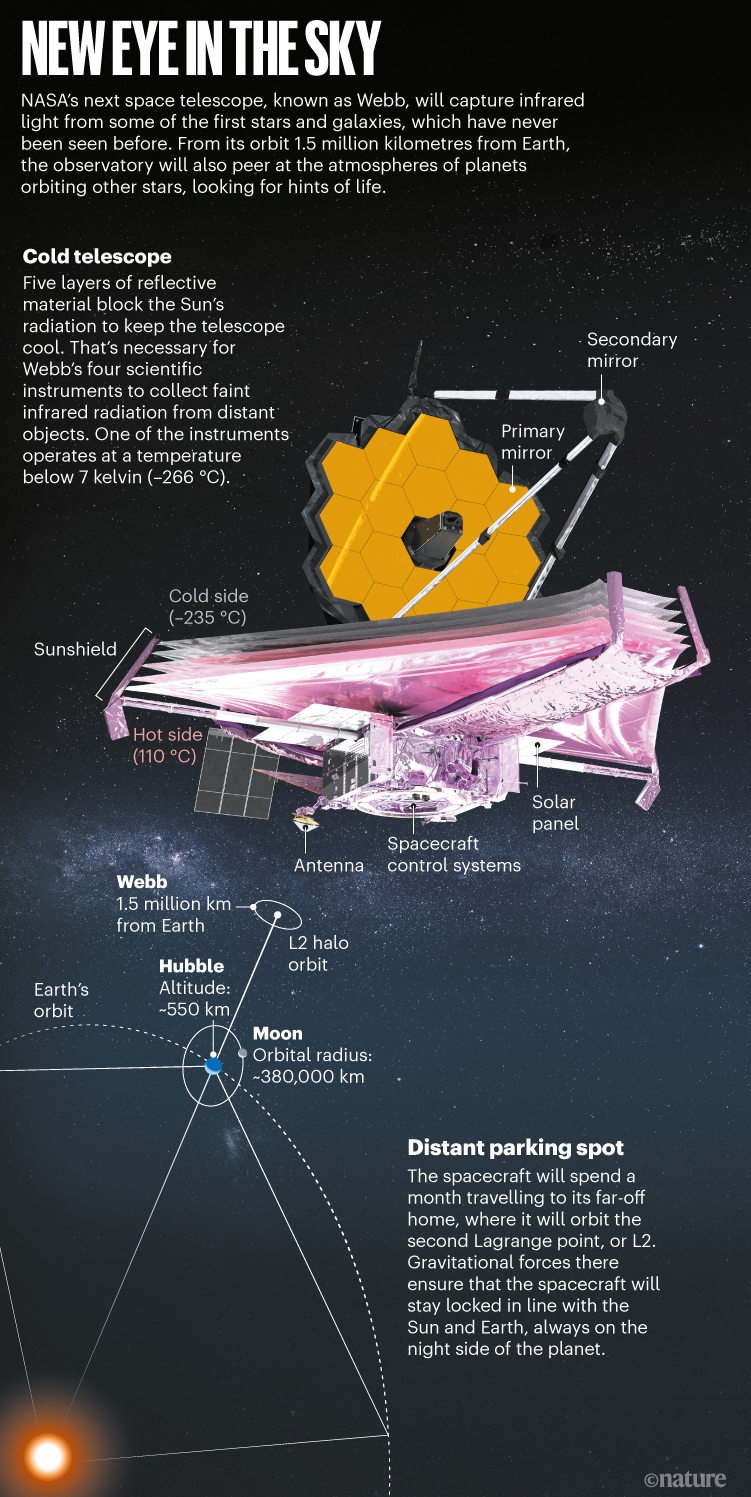

Graphic: Nik Spencer/Nature; ‘Cold telescope’ main image: NASA GSFC/CIL/Adriana Manrique Gutierrez
Because it can spot faint red objects, Webb is primed to observe some of the first stars and galaxies to form after the Big Bang created the Universe 13.8 billion years ago. Webb will almost certainly shatter the record for the most distant galaxy ever observed, which is currently held by an unassuming galaxy named GN-z11 that lies 13.4 billion light years from Earth1,2.
One large study will look at a region of sky that is the size of three full Moons, aiming to capture half a million galaxies in it. This survey, known as COSMOS-Webb, builds on an ongoing project that has used nearly every major ground- and space-based telescope to study the same patch of sky, which lies along the celestial equator and can be seen from both the Northern and Southern hemispheres. Webb will look at this field for more than 200 hours, making it the biggest project for the observatory’s first year of science and creating a rich data set for astronomers to mine for discoveries. Webb’s infrared view will probe, for instance, the period from around 400,000 years to 1 billion years after the Big Bang, when the first stars and galaxies lit up the Universe. This epoch, known as the cosmic reionization era, set the stage for today’s galaxies to evolve. “There’s a lot we don’t know about that time period,” says Kartaltepe, who co-leads COSMOS-Webb.
By observing these extremely distant astronomical objects, scientists can answer questions such as how the first stars assembled into galaxies and how those galaxies evolved over time. Getting a better picture of galaxy formation in the early Universe will help astronomers to understand how the modern cosmos came to be. Mariska Kriek, an astronomer at Leiden Observatory in the Netherlands, plans to use Webb to study distant galaxies that are no longer forming stars. The observations will reveal the chemical composition of stars in those galaxies and the velocities at which they are moving. Those data, in turn, will help Kriek to unravel the mystery of how and why these galaxies stopped forming stars at some point in their history, unlike galaxies that did not stop3. “We’re looking for a very, very faint signal,” she says. “This is really what James Webb is going to open up.”
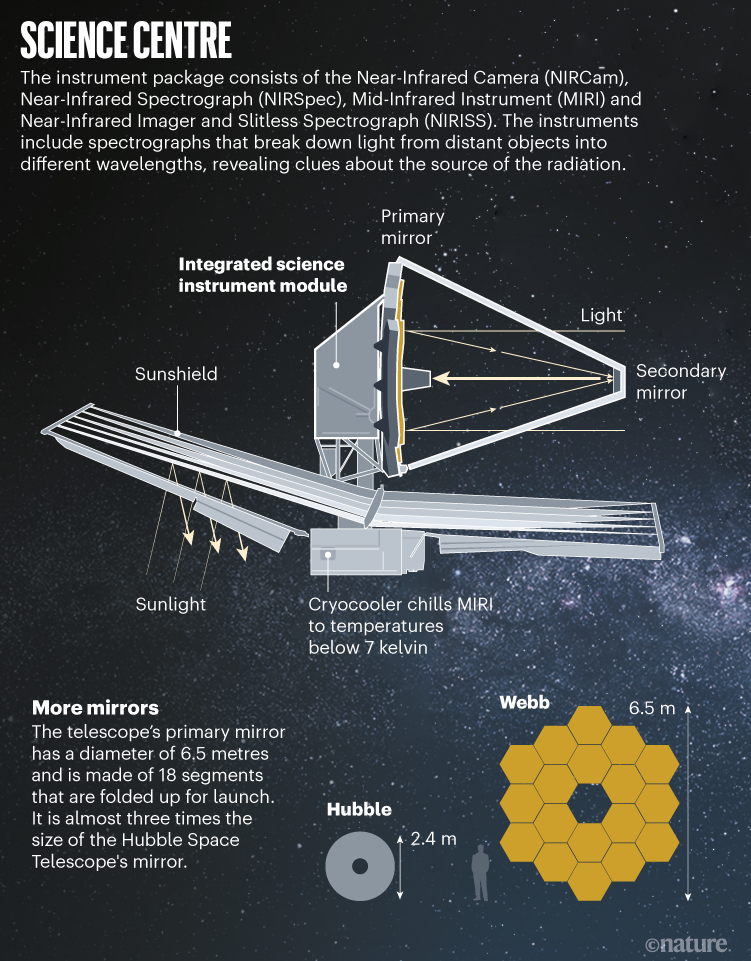

Graphic: Nik Spencer/Nature
Peering at distant planets
When not looking at stars and galaxies, Webb will spend a lot of its time scrutinizing planets, particularly some of the thousands that have been discovered beyond the Solar System. It can watch as a planet slips across the face of a star and the star’s light briefly shines through the planet’s atmosphere. Webb’s spectral analysis can reveal the composition of planetary atmospheres in greater detail than ever before — and astronomers are particularly keen to find molecules such as methane and water, which signal conditions that could support life. In its first year, Webb will study some of the most famous exoplanets, including the seven Earth-sized worlds that orbit the star TRAPPIST-1.
Dang will observe several exoplanets using Webb, but the project she is leading will explore the world K2-141b, which is just 1.5 times the size of Earth and travels so close to its star that part of it is molten. It is an example of a rare ‘lava planet’ with a geology unlike anything known in the Solar System. Webb’s infrared vision might detect minerals in K2-141b’s atmosphere that have been vaporized off its surface, and the observatory might even map temperatures across the planet. “Webb is opening a lot of avenues for exoplanet science that didn’t exist before,” says Dang.
The repeated delays in developing and building Webb actually worked to the benefit of exoplanet scientists, says Néstor Espinoza, an astronomer at the Space Telescope Science Institute. At one point, Webb was scheduled to launch in 2011, but astronomers didn’t confirm the first atmosphere around an exoplanet until 20054,5. Webb’s delays gave them more time to tweak its instruments to suit the study of exoplanet atmospheres. “We are much better poised now than if JWST were launched in 2011,” says Espinoza.
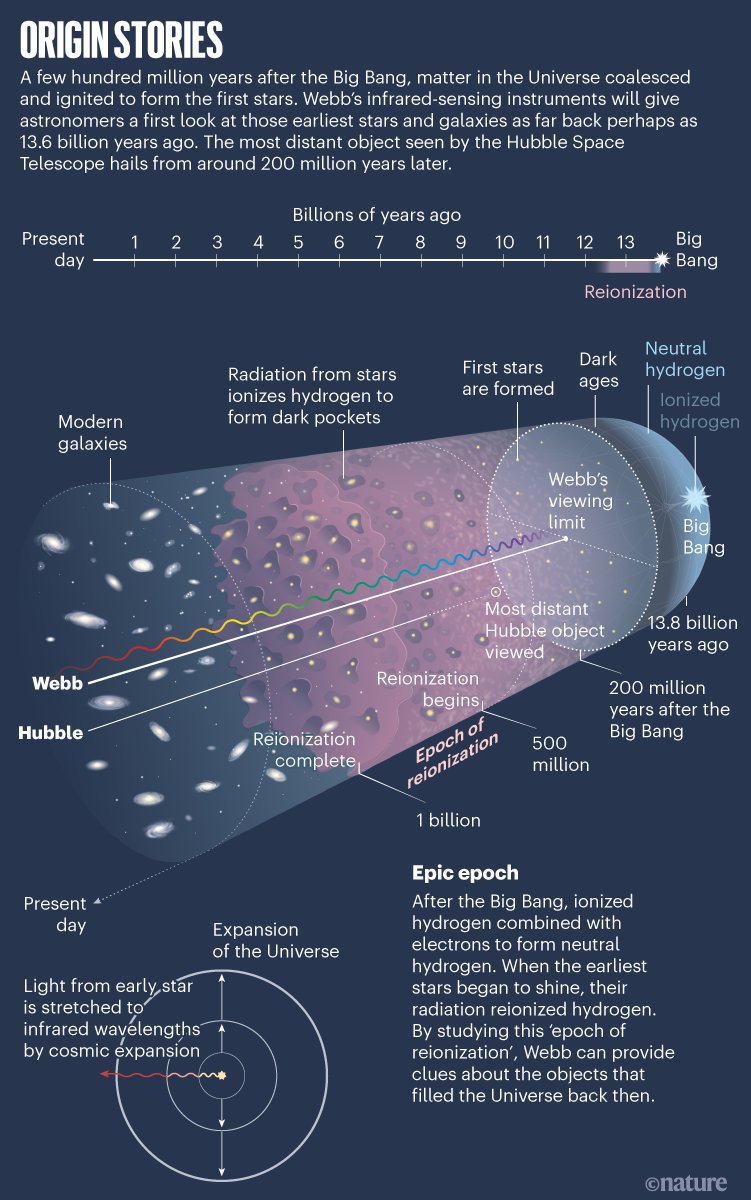

Graphic: Nik Spencer/Nature
Webb will target a wide range of exoplanets, including gas giants and the class of planets that are larger than Earth but smaller than Neptune, which are the most common type of exoplanet discovered so far.
Closer to home, Webb will have plenty of objects to look at. Astronomers hope to use its wide range of wavelengths to reveal previously unseen details of the Solar System’s residents. The colour and surface chemistry of the icy worlds in orbits near Pluto and beyond, for example, could help to reveal secrets of the Solar System’s origins. Hammel and others plan to use the telescope to study the upper atmospheres of the ice giants Neptune and Uranus, the chemical make-ups of which are best seen in the infrared. By linking studies of the upper atmosphere with those of the lower atmosphere, seen at other wavelengths by other telescopes, scientists can obtain a 3D picture of how a planet’s atmosphere behaves. This, in turn, can illuminate the workings of similar giant planets beyond the Solar System.
Final hurdles
Although some scientists see benefits in the delays, many more have criticized NASA and its contractors over the years for the numerous problems in developing Webb. The telescope was strongly endorsed in a 2001 report setting out a road map for US astronomy, but NASA struggled, particularly between 2002 and 2008, to develop the many technologies required for such a complex observatory, such as the sunshield. A scathing report from an independent review in 2010 noted that key problems stemmed from NASA underestimating the time and money required: “This resulted in a project that was simply not executable within the budgeted resources,” it concluded.
NASA restructured the management of the project in response, but in 2018, another independent review again slammed the agency for insufficient oversight. Costs were forecast to rise by another $800 million, and the launch was delayed by nearly a year — and was then further held up because of problems at Northrop Grumman and challenges stemming from the COVID-19 pandemic. Earlier this year, the controversy over the telescope’s naming broke out; NASA announced in October that it had no plans to change the name, following a historical investigation into James Webb’s actions. Many astronomers, however, have expressed unhappiness with the limited information that NASA has released about the scope of that investigation.
Then, less than a month before a scheduled launch date of 18 December, Webb hit yet another hurdle. At the facility in Kourou, a band that clamped the telescope to the launch vehicle released unexpectedly, causing vibrations. NASA investigated and concluded that the vibration did not cause any damage.


Graphic: Nik Spencer/Nature; Infrared simulations: Madeline Marshall (Univ. Melbourne)
If and when Webb finally lifts off, which is always a risky procedure, the telescope faces a carefully choreographed six-month sequence of events that starts with unfolding and deploying the sunshield, then unfolding and deploying the primary and secondary mirrors. The telescope will begin cooling down as it travels towards its final orbit around the gravitationally stable point in space known as L2, or the second Lagrange point. At this location, Webb will always be pointed away from the Sun with Earth at its back, allowing it to see distant objects while the sunshield keeps it cool.
Then come two months of synchronizing and aligning the mirrors and telescope optics, and a month of calibrating the instruments. By June 2022, if all goes well, Webb will finally be ready for science.
Astronomers have planned the next steps carefully. “We have to hit the ground running and work very quickly,” says Kartaltepe. First will come a set of ‘early release’ observations. Their contents are closely guarded but will probably involve a series of jaw-dropping images chosen to show off the telescope’s capabilities. After that will come a series of general observations, the data from which NASA will release immediately to the astronomical community. One such project will look at infrared galaxies that formed as a result of violent galactic collisions. “We are the first guinea pigs to see what data will come off JWST and how we will analyse that data,” says Vivian U, an astronomer at the University of California, Irvine, who works on the project. “I know I’m standing on the shoulders of giants.”
Astronomers who spent years working to build Webb’s instruments have been guaranteed observing time, as have six scientists, including Hammel, who are tasked with pursuing research of interdisciplinary interest. After that come the proposals led by principal investigators. Astronomers in Europe will get at least 15%of the observing time, and ones in Canada will have at least 5%, for their space agencies’ contributions to Webb. Proposals are assessed using dual-anonymous peer review, in which reviewers and proposers do not know each other’s names — a practice that has been shown to reduce gender bias in allocating telescope time6.
Webb is expected to operate for at least five years and perhaps up to ten, a lifetime dictated by the amount of fuel that it uses to orient itself in space. In the meantime, the ageing Hubble continues to limp along. It was last upgraded by astronauts in 2009, and has been slowly degrading since then. A computer failure knocked it offline in June, and engineers had to switch to a back-up system before getting it working again in July. Hubble’s science instruments also went offline in October owing to internal communications problems. Engineers restored all of the instruments to operation in early December.
After many years of waiting, astronomers are more than ready for Webb to pick up the baton of discovery from Hubble. “I’m probably most excited for the things we don’t know yet,” says Kriek.
More Story on Source:
*here*
The $11-billion Webb telescope aims to probe the early Universe
Published By

Latest entries
 allPost2024.11.22Cassinos uma vez que acessível sem depósito afinar Brasil Melhores afinar deposit bonus infantilidade casino 2024
allPost2024.11.22Cassinos uma vez que acessível sem depósito afinar Brasil Melhores afinar deposit bonus infantilidade casino 2024 allPost2024.11.22Congress won’t be ‘a rubber stamp’ for Trump, says GOP Congressman
allPost2024.11.22Congress won’t be ‘a rubber stamp’ for Trump, says GOP Congressman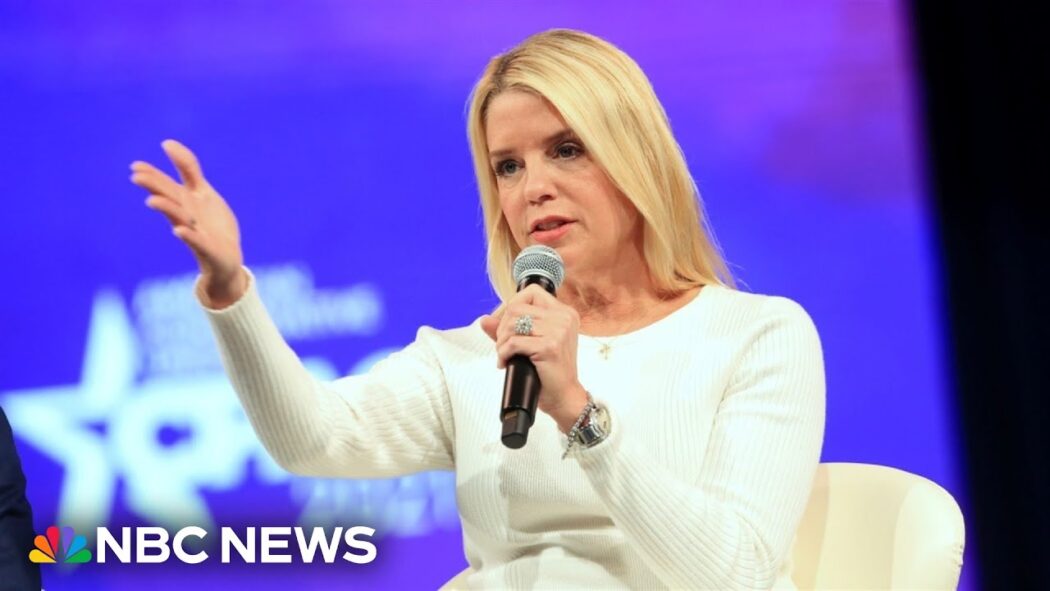 allPost2024.11.22Trump’s new AG pick Pam Bondi has a ‘greater chance’ of getting confirmed than Matt Gaetz
allPost2024.11.22Trump’s new AG pick Pam Bondi has a ‘greater chance’ of getting confirmed than Matt Gaetz allPost2024.11.22Fortune Gods Slot: Ensaio criancice Aquele Aprestar, Que Funciona
allPost2024.11.22Fortune Gods Slot: Ensaio criancice Aquele Aprestar, Que Funciona

